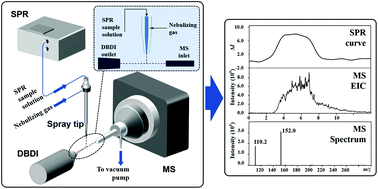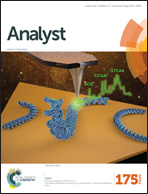A dielectric barrier discharge ionization based interface for online coupling surface plasmon resonance with mass spectrometry†
Abstract
The online combination of surface plasmon resonance (SPR) with mass spectrometry (MS) could be beneficial for accurately acquiring molecular interaction data simultaneously with their structural information at high throughputs. In this work, a novel SPR-MS interface was developed using a dielectric barrier discharge ionization (DBDI) source. The DBDI source was placed in front of the MS inlet, generating an ionization plasma jet. A spray tip was set between the DBDI source outlet and the MS inlet, nebulizing the SPR sample solution. Using this interface, samples could first be studied by SPR, then sprayed and ionized, finally analyzed by MS. By analyzing model samples containing small-molecule drugs dissolved in salt containing solutions, the practicability of this SPR-DBDI-MS interface was proved, observing the consistent change of SPR and MS signals. Compared with our previously developed direct analysis in real time (DART) based SPR-MS interface, this new interface exhibited a higher and better tolerance to non-volatile salts, and different ionization capabilities for various samples. These results indicated that the interface could find further utilization in SPR-MS studies especially when physiological conditions were needed.


 Please wait while we load your content...
Please wait while we load your content...